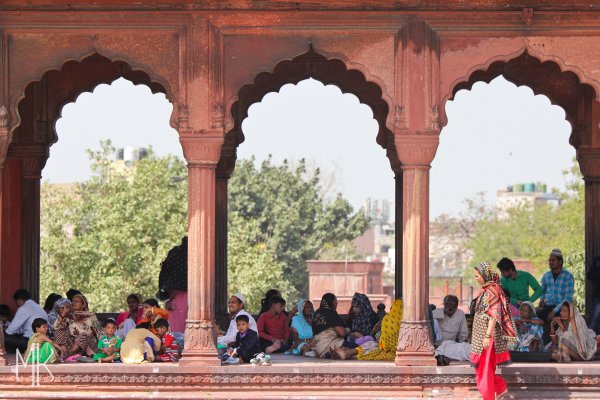
Published at ALNAP on August 19, 2021
UN World Humanitarian Day 2021 focuses on the consequences of the climate emergency for the world’s most vulnerable people. To mark the theme, Mihir Bhatt from the All India Disaster Mitigation Institute (AIDMI) highlights some key learning on adapting to heatwaves that has emerged from research for ALNAP’s upcoming lessons paper ‘Adapting Humanitarian Action to Climate Change’.

Escaping the heat. Jama Masjid, Old Delhi (India). Photo credit: MK Photography.
Over the past decade, the world has been subject to increasingly severe heatwaves at a rate we have not seen before. As temperatures around the world rise, so does the risk to human health, the environment and our way of living. As humanitarians, we are aware that extreme climate events will disproportionally impact the world’s most vulnerable people, but as a sector we seem to know little about the actions we should take or not take when preparing the policies, programmes or projects to deal with them.
2020 was one of the three warmest years on record – rivalling 2016 for the top spot. In 2021, parts of western Canada and north-western US reeled under an intense heatwave of record-breaking temperatures, which left many dead. In North India, a delayed monsoon and rising temperatures have left millions exposed to the sweltering heat as New Delhi hit a nine-year temperature high. According to the latest sobering report from the Intergovernmental Panel on Climate Change (IPCC) – the world’s foremost authority on climate science – these extreme events are just a taste of what’s to come.
At AIDMI we have tried to keep pace with the steep learning curve of adapting to heatwaves in India and beyond. In doing so, we have worked closely with vulnerable groups such as children, daily wagers, traffic policeman and slum dwellers, who are highly exposed to the adverse impacts of extreme temperatures. Our experience has revealed the need for greater public and private investments for adaptation as well as for robust evaluation of heatwave preparedness and response. We have also noted the negative impacts of heatwaves on farm produce and aquaculture in India.
Throughout the past four months, we have been working alongside colleagues from Groupe URD and the Climate and Humanitarian Crisis (CHC) Initiative to research and write ALNAP’s forthcoming lessons paper focused on adapting humanitarian action to the effects of climate change. As part of this process, we examined over 200 peer reviewed publications on climate change to draw out lessons for adapting to heatwaves in humanitarian contexts. A full list of lessons will be available when the paper is launched in the autumn. Ahead of this, we have highlighted three key lessons from the paper that provide ways to support vulnerable people to adapt to the threat of heatwaves.
1. Consider the vulnerabilities of specific groups
One of the most important lessons emerging from the review of the literature has been to focus on the specific vulnerabilities that heatwaves pose to different socio-economic groups. For instance, pregnant and lactating women, children and the elderly are more vulnerable to the adverse impacts of heatwaves due to their underlying physiological and health conditions. Similarly, people involved in certain livelihood activities such as daily wagers, roadside vendors and traffic police are exposed to the threat of extreme heat because they are required to work under the scorching sun often with little shade or respite.
Furthermore, migrants who move from rural areas to the cities and end up in informal settlements, such as slums, can be vulnerable to poor housing conditions. Accommodation may not have basic WASH (water, sanitation and hygiene) or energy amenities (such as a 24/7 power supply) to cope with heat stress or it may have features which do not adapt well to the heat – such as roofs made of tin sheet. Therefore, humanitarian agencies need to factor in the differentiated vulnerabilities of these diverse groups while devising their heatwave action programmes.
2. Improve community awareness
Engaging with vulnerable communities to improve their awareness of the dangers of extreme temperatures is also an important lesson in adapting to heatwaves. Communities should be directly involved in heatwave action planning at home and at work, whether that is by a woman vegetable vendor on the streets of Delhi or an investment finance expert in a corporate office in Mumbai. For instance, in Ahmedabad’s (India) heat action plan (HAP) special impetus was given to public engagement and awareness building through the use of a diverse range of channels (billboards, media alerts, advertisements, messages through mobile applications such as WhatsApp, and citizen-awareness walks in at-risk neighbourhoods) to ensure the message reached every group in society.
3. Lobby governments to protect the most vulnerable
Finally, humanitarian actors must lobby governments to expand social protection for vulnerable communities against heatwaves. An effective partnership between humanitarian agencies (which help in identifying the vulnerable groups), insurance companies (that operationalise social protection mechanisms) and governments (that actually foot the bill for these increased social protection measures) can help to protect the most vulnerable.
Moving forward, we need to identify what works for the most vulnerable groups and then scale it up. This would require a re-imagining of the relationship between humanitarian actors and vulnerable communities, an increase in emergency financing and greater collaboration between governments, humanitarians and the private sector to encourage innovative solutions. As the world scorches under the relentless and record-breaking heat of 2021, it will be cool to remember these lessons for adapting to the threat of heatwaves in the coming future.
This blog discusses only some of the lessons on heatwaves presented in ALNAP’s forthcoming lessons paper. The paper will also provide lessons on new forms of tropical storms and on anticipating, adapting and responding to climate crises more broadly. Visit ALNAP’s full catalogue of lessons papers.
Mihir Bhatt is working alongside Paul Knox-Clarke (CHC Initiative) and Francois Grunewald, Veronique De Geoffroy and Johana Bretou-Klein (Groupe URD) on the forthcoming ALNAP lessons paper ‘Adapting humanitarian action to climate change’.